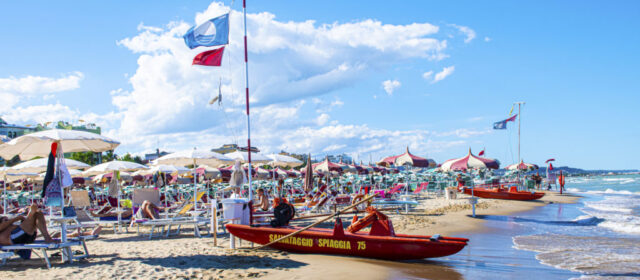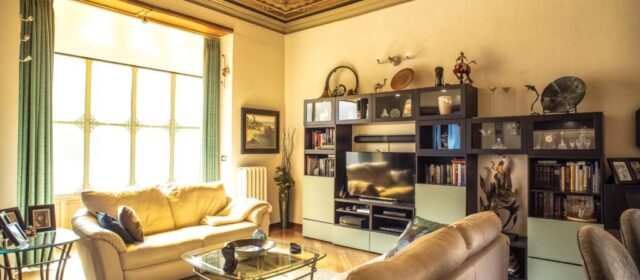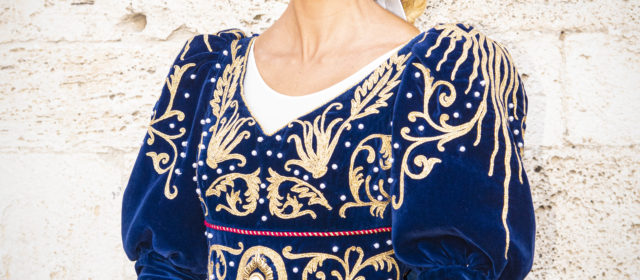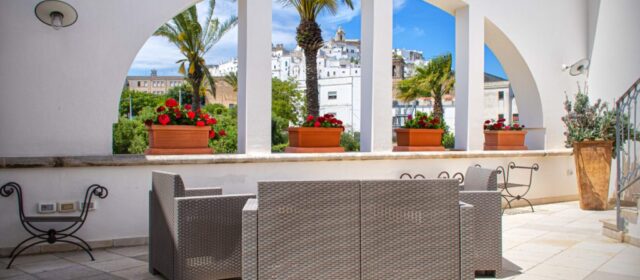ON THE ROAD, DOWN SOUTH The timing we arbitrarily chose for our Fall travel excursion by car was fortuitous. Not long after our return to Ascoli from southern Italy, the resurgence of COVID-19 infection rates has caused the government to reinstitute more restrictive measures. In the current environment of more constrained movement and activity, I’m not sure the same travel experience would have been possible for much longer. But whatever the reason behind our timing, we are glad to have had the adventure when we did. The broad brush of history has always interested me. The cultural history of the Mediterranean is a fascinating study of the interactions of diverse peoples over centuries. Emerging cultures expanded their reach and influence by becoming Mediterranean maritime nations. The geographic significance of the positioning of Italy is apparent. Even a cursory glimpse at a map of the Mediterranean Sea reveals the long, narrow peninsula of Italy jutting out into that large body of water. With the crisscrossing of seafaring cultures through the Mediterranean, it was inevitable that the southern tip of the Italian Peninsula sticking out as it does, would have been a stopping-off place for seafaring explorers in search of adventure and the riches they hoped to come up with. The multicultural immersion of southern Italy, with many of their residual remnants having made their mark, is just one of the reasons for it to be an interesting travel destination. Our most recent Blog briefly reported we had made a car excursion into southern Italy. We had set out from Ascoli in early October and headed south, on the Adriatic Coastal Plain, driving on the Autostrada A-14. After some five and a half hours, our first stop was at the ancient town of Matera in the Basilicata Region. The distinguishing feature of this area is the presence of cave dwellings that represent the oldest, known continuously inhabited, cave dwellings in the world. The cave complex has been carved into the walls of deep river canyons over time. The imprint of human existence here is very long. The granular, calciferous rock in this area is of generally uniform texture, appearing quite solidly stable while also being responsive to early human...
Read MoreAutumn has arrived in Ascoli. Right on schedule, with the Autumn Equinox on the 22nd of September, the air started to cool. No more going out without a light jacket. Mostly sunny days began to give way to more frequent afternoon rain showers. The wind also began to pick up signaling changes were underway. At night, the faint smell of fireplace wood smoke is now apparent in the air. Also as predicted, the Fall has brought with it an increase in the number of COVID-19 reported new cases. This trend is being reflected worldwide and of course, Ascoli has not been spared. However, the situation continues to be relative. During the Summer, the Province of Ascoli Piceno reported generally fewer new viral cases than elsewhere. Now in October, this Province, while seeing an untick, is currently reporting fewer new cases daily than some other areas. Unfortunately, a disproportionate percentage of the new cases appear to be connected to the return to in-person school classes. Italy was criticized in the initial stages of the contagion. Mass attendance sporting events in Northern Italy, prior to any awareness that a biologic threat was present, resulted in high levels of infection which subsequently overwhelmed the healthcare system. Perhaps, having witnessed what this unforeseen biologic disaster had done to Italy, may have stimulated a more proactive public health response in other countries – at least in those places under the stewardship of more prudent and responsible leadership. After some initial flailing about searching for solutions for something inadequately understood, Italy got its act together and significantly reduced the rate of viral spread. The overall result has been Italy has faired much better over the course of this contagion than some other places. Consistent with the more prudent approach to prioritizing public health taken here, the national leadership has reimposed 24/7 mask wearing and other measures to arrest increasing infection rates. The measures are being reinforced by the imposition of fines. With this writing, the government is imposing curfews, restrictions and closings of some businesses where larger groups of people tend to congregate, becoming viral contagion resurgence ‘hot-spots’. We are seeing an overall increase in compliance in the general population particularly in mask wearing....
Read MoreSUMMER AND PANDEMIC IN ASCOLI PICENO A pandemic, like anything unwelcome and unanticipated, has a way of upsetting how we go about our lives. We haven’t posted much for a while. It isn’t that the process of reflecting on what has been happening wasn’t going on. The problem has been, not knowing how to say anything coherent about it. With the last Blog entry this Spring, it had become evident a worldwide viral contagion, a pandemic, was in process of making radical changes to all our lives. The ground under us was suddenly becoming very unfamiliar. And with it, confidence eroded in the ability to make viable plans. Apprehension of the unknown, replaced a capacity for positive anticipation. An awareness was forced on us of the fragile nature of life. A deeper perception of our vulnerabilities has been an understanding we were not well prepared to confront. The initial stages of viral contagion began to spread more rapidly than world-wide health resources were able to adequately understand and mount an effective response. Italy was caught off guard. Earlier mass gatherings in northern Italy, at a critical time in the infection cycle, resulted in serious public health issues. Although currently, that situation is under much better control. The Province of Ascoli Piceno, where we live, is in the Marche Region. This area is a more rural and self-sufficient part of Italy, less densely populated than the more highly commercial, globally interactive north of the country. We often use the phrase, off the beaten track, to refer to this area. During a pandemic, that factor appears to have become a valuable asset. The governing authorities of the Marche Region were among the first in Italy to take appropriate, decisive action to reduce the potential spread of the viral contagion. The result has been, this Province has had one of the lower viral infection and mortality rates compared to much of Italy. As of this writing, we continue to be in that more favorable position. At the time of the last Blog entry, we had already been in an enforced ‘lock down’ restricting social interaction. The initial very restrictive lockdown lasted the better part of three months. That was followed by some...
Read MorePANDEMIC When preparing a Blog, I find myself sorting through the range of experiences we are having and trying to decide if any of them might make more interesting ground to be explored through writing. But never in my wildest imaginings had I considered the possibility that all our lives were about to have to deal with such a radical change brought on by a pandemic. I know we are not alone in feeling what we are currently confronting globally, seems surreal. Culturally, we are a people who celebrate ‘being in charge’, and now we are cowering in place in an effort to protect ourselves from something we can’t see. Mass biological calamities are not total strangers in a world brought in closer proximity through commercial globalization. No longer is it possible to ignore a serious disease outbreak in a remote corner of the world. The rapid, intercontinental exchange of people and goods ensures what happens elsewhere, doesn’t stay elsewhere. Scourges like Ebola, SARs and AIDs were identified and the likelihood of affecting human populations over wide areas was, in due course, understood and responded to in time to increase the effectiveness of the response. But something seems different this time with the COVID-19 outbreak. It is too early in this experience to understand the complex factors affecting the devastating effect this viral outbreak is causing. Standing in the midst of a crisis is not the best vantage point for perspective. But several components might be considered. Of course, there is the unique makeup of this strain of virus that was insufficiently understood. More on that in a moment. In addition, it is difficult to escape the perception that some politically fixated objectives seriously complicated timely, accurate assessment as to what the world was too soon to be confronting. In an authoritarian regime such as China, there is an institutional aversion to be a source of ‘bad news’ the regime would prefer to not have to deal with. The ingrained propensity of authoritarians to ‘kill the messenger of bad news’ does not encourage timely dissemination of critical information that needs to be confronted. Valuable time was lost both in the initial assessment of COVID-19 biohazard but also disseminating...
Read MoreIt appears since pre-historic times, once our human species concentrated themselves into groups for mutual support, rituals evolved as a means to build a sense of common community. Across widely diverse cultural differences, attentiveness to the rhythms of nature has given a special significance to the astronomical observation of the Winter Solstice. Solstice rituals have brought people together for millennia to express jubilation that the long night of winter had begun the slow, but anxiously anticipated assent out of darkness. The coincidence of the timing of the observance of spiritually significant events and the astronomic timing of the Winter Solstice seems apparent. The significance of the coincidence in the timing of the celebration of the Christmas festival established by the early Roman Christian Church and the already established Roman Pagan Solstice festival of the Saturnalia, remains a matter of debate in some theological circles. That is an esoteric issue which we will, happily, bypass. Our 7th Festival of Christmas in Ascoli has just concluded. Ascoli adheres to the Italian custom of not ‘officially’ initiating the Christmas celebrations until December 8th with the Roman Catholic Church observance of the Feast of the Immaculate Conception of the Blessed Virgin Mary. The official end of the Christmas celebration is on the twelfth day of Christmas coinciding with the observance of Epiphany, relating to the New Testament description of the arrival of the Three Wise Men bringing gifts to the Christ child. On a very chilly, late Epiphany eve, we went out to take a last look at the Christmas lights in the historic center of Ascoli Piceno. Immediately after Epiphany, crews will be out promptly, taking the lights down. We went with a camera on our walk to record some of this ending Christmas season’s lights and thought we might share a few of the photos with you. The photo above is of the Piazza Del Popolo looking south from the Church of Saint Francis at the north end of the Piazza. The Piazza Del Popolo is a Renaissance jewel paved in Travertine stone polished by passersby over the centuries. ...
Read MoreAwaiting the Solstice It is now only been a short time since we have returned to Ascoli and are, once more, comfortably installed in our apartment. I say, ‘comfortably’ with the caveat that with age, overcoming ‘Jet Lag’ seems to take longer. The ‘Jet Lag’ is a result of a little over three-week trip to return to the U.S. for some important, personal visits and to take care of a few logistical matters. Although we were last in the U.S. in January of this year, we had a sense that Arlene’s mother’s health status may have become more complex, and my older brother is in process of dealing with the aftermath of several strokes. We also wanted to see our three daughters and as much of their families as might be available now that the ‘grandchildren’ are all young adults starting out in varying degrees of independence on their own. The visits were an uplifting mixture of that special experience of being in each other’s presence that no amount of electronic, ‘virtual communication’ can provide. Additionally, there is also that more immediate realization that some less than desirable developments are occurring in the lives of people we care about, over which we have no control. This is an all too common dilemma in the later stages of life in transitioning from attempting to be the ever-present problem solver to stepping back into still caring but recognizing one is no longer a viable, solution resource you wish you could be. A two week visit in the San Diego area also permitted seeing some old friends and catching up. A special affirmation is experienced in being around people you have known and cared about for a long time and no amount of physical distance can diminish the feelings of affection. There was also a strange sensation of driving around in a place in which we had previously lived but no longer do. Some old mental files were dusted off and it seemed, at least most of the time, I knew exactly how to drive to where we needed to go. But underneath it all, I felt very much like a stranger in a very familiar place. It seems I have...
Read MoreTHE JOUST OF THE QUINTANA – 2019 Each year, for over sixty years, the Ascolani people have reenacted a pageant with roots going back to the tournaments staged by knights (Cavalieri) in the Middle Ages. These contests are themselves known by the term, Quintana, traceable back to the Roman Empire when encampments of the Imperial Military staged contests to promote physical prowess and morale. The Ascoli Quintana Pageant begins in mid-July and concludes after the first week in August. The Ascolani participants in the principal events are costumed in authentic reproductions of the attire worn in this area during the Renaissance. The designs are based on the depictions painted by a renowned local, Renaissance artist, Carlo Crivelli. Like much of Central Italy east of the Apennine Mountains, Ascoli is sufficiently ‘off-the-beaten-track’ that the spectacular of the Ascoli Quintana is not as well known as the Palio in Sienna or the Regattas or Carnevale in Venice. But there is nothing in second place in what the Ascolani present. The participants spend much of the preceding year in preparation and rehearsals. The highest production values are in evidence in what the Ascolani present in the Quintana. The enthusiasm displayed by the Ascolani exudes their intense pride-of-place. An interesting side note in the Quintana reenactment is to appreciate that many of the costumes that have been traditionally worn in the Quintana by members of the communities to the west of Ascoli, were damaged beyond repair in the series of earthquakes that struck the area some two years ago. In an outpouring of assistance, funds were donated from a variety of sources that made it possible to reconstitute this cultural heritage resource. In the photos below, many of these costumes from communities to the west are the newly replaced ones. One more demonstration of Italian pride of place and sense of communal connectedness. Within the historic center of Ascoli, where we happen to live, the city is subdivided into six neighborhood areas called Sestieri. It is the competition between the Sestieri that forms the backdrop for many of the events of the Quintana. In addition, smaller towns surrounding Ascoli also participate in the pageantry and compete in some of the events. The depicted relationship of these...
Read MoreSUMMER IN ASCOLI PICENO It is now early September. Time, and the seasons with it, seem to be moving faster and faster. Most people from North America recognize ‘Sunny Italy’ to be located in the southern portion of Europe. While that is quite literally true, in reality, we have been living in Central Italy at a point that is a full ten degrees of Latitude further north than our former home in San Diego, California. As a result, we have had to make adjustments to our conditioned expectations as to when seasonal changes are likely to occur. Another adjustment factor involves the irrefutable evidence that changes in climate patterns are continuing to occur. In the brief six years we have made this place our home, we have detected subtle changes that have occurred year-to-year. Spring at this latitude seems to have become compressed from being a gradual transition into an almost binary change from late winter into early summer. Over more recent years, the more mild and pleasant months of May and into June have tended to remain somewhat damp and chilly. And then there has followed an almost abrupt, abbreviated transition into very warm, make that very hot, summer weather. For those of us from North America, we tend to think of the American observation of ‘Labor Day’ in early September as a pivot point around which the anticipation of the arrival of Autumn takes place. Here in Central Italy, the observance of ‘Ferragosto’, the traditional holiday break decreed to be on August the 15th by the Roman Emperor, Augustus, becomes the emotional transition point for anticipating seasonal change. As in most of Europe, here in Italy, August is the traditional month for vacations, so don’t plan on getting much of anything done in Italy during that period. In Italy, non-vacation-oriented activity seems to come to a virtual stand-still. Family vacations in most of the world tend to favor summer for travel. The mass tourism industry has responded and grown exponentially to service this market. As a result, culturally interesting locations, with Italy high on that list, have become inundated by the overcrowding inherent in mass tourism during the summer. We agree with others who have travelled and lost any enthusiasm...
Read MoreSPRING IN ITALY According to the calendar, astronomically, the spring season is supposed to have begun on the 20th of March. It appears even in this time of almost instant, electronic communication, that message has been slow in arriving here in Ascoli. In reality, as of this writing in late May, we are still having a replay of last years’ experience with a reluctant retreat of winter and a very slow arrival of the much anticipated warmer, spring-like weather. At least the botanical realm appears to be on schedule. The trees are in full leaf and brilliant wild flowers decorate the roadsides and the fields. Another traditional feature of springtime is the presence of some yellow pollen traces on our outdoor terrace floor. But that’s what antihistamines were developed to handle. Our regular, rented spot on a sandy beach on the Adriatic is all lined up again for the summer. We had hoped to have gone down there for some early beach days by now, but the slow onset of beach-weather has discouraged that. If the weather pattern will be a repeat of last year, over a short period we will transition from late winter almost instantaneously into early summer. We are ready. The month of May is special in our lives as our wedding anniversary falls on the 21st. This year, we are celebrating our 31st anniversary. As we reported in this Blog, last year for our 30th, we enjoyed two weeks in the south of France. This year, we took a more modest celebratory trip a little closer to home. We went on a three-day holiday, by convenient train, to the south of Italy. We chose a place also on the Adriatic, in the region of Puglia, otherwise described as the heel of the boot of Italy, to explore the ‘White City’ of Ostuni. The town is situated on an elevation about 8 km inland from the Adriatic coast. As we understand it, the predominance of white on the majority of the buildings is tracible to the period of the Great Plague when applications of Lime were thought to have disinfecting qualities. Added to that, Ostuni was at one-point part of the Magnum Greco, or Greater Greece, with...
Read MoreCarnevale underway from the interior of the thirteenth century Palazzo dei Capitani on the Piazza del Popolo in Ascoli Piceno THE FACES OF CARNEVALE It has been Carnevale time in Ascoli Piceno. In the U.S., the New Orleans celebration of Mardi Gras is another iteration of raucous celebration that may have its roots in ancient, pagan celebrations in anticipation of the arrival of spring. Not long after Christianity made the transition from a persecuted religious sect to become the State Religion of Imperial Rome, the hierarchal structure of the Roman Christian Church was essentially all that was left of a coherent organization after the fall of Rome to the invading Teutonic hoards from the north. In time, the secular power of the Roman Christian Church continued to increase to the point where even the structure of the civil calendar was determined by the Vatican. It is a curious artifact that with all its power, the Roman Christian Church was not able to eliminate what appears to be an even more ancient joyful rite of abandon speculatively suggesting, sensual indulgence in anticipating seasonal change – what we know today as Carnevale or Mardi Gras. The most the church was able to do was to push Carnevale ahead of the pre-Easter observance of Lent. Nothing could be more antithetical to the theme of Lent in which the faithful needed to display penitence and a devotional need for redemption from the sins of indulgence in the deadly vices. During Carnevale, no self-denial here. Restrained decorum and displays of humility – not anywhere to be seen. There is so much in Carnevale and Mardi Gras symbolism that is clearly much closer to pagan sensuality than Judeo-Christian piety. There may be some connection with some of the more sensual and ribald themes seen in Carnevale with ancient springtime associations with fertility. In some respects, the underlying curious duality that exists in Italian culture is illustrated by the contrast between the public piety on display during the observance of Easter and the self-abandoned sensuality inherent in Carnevale. Culturally, many Italians identify themselves as Catholics. But under the surface, the Italian indifference to hierarchical authority comes to the surface and spills over in unabashed self-indulgence that is...
Read More










Recent Comments